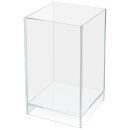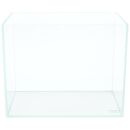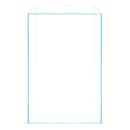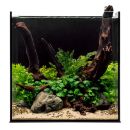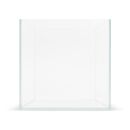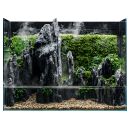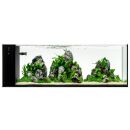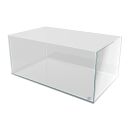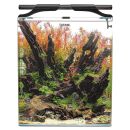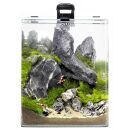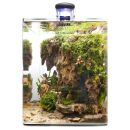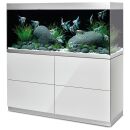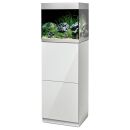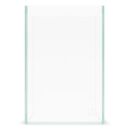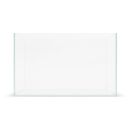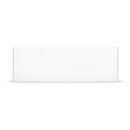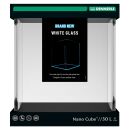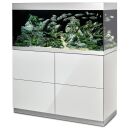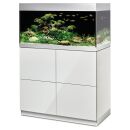White Glass Aquarium
For aquariums, besides the expensive and very scratch-prone acrylic, the two materials float glass or white glass come into question. White glass, often known by the market names OptiWhite or Diamond Glass, is the highest quality grade for aquarium fabrication and is therefore a great choice for the foundation of an aquascape or aquarium landscape.
Similar to float glass, white glass is manufactured through what is known as the ?float? process. In this method, the molten glass is heated to about 1.100 °C and passed onto a bed of liquefied tin. The glass floats on this tin layer during processing. More important than the process itself, however, are the raw materials. In addition to quartz, other components such as soda and dolomite are needed in the production of flat glass. Oxide compounds such as iron oxide or titanium oxide in the raw materials influence the colour neutrality of the glass. Iron oxide, for example, produces a slight green tint, titanium oxide a brown tint. The purity of the raw materials is therefore decisive for the quality of the end product. If the proportion of iron oxide in the glass is below 200 ppm (parts per million), it is defined as white glass. So the fewer oxide compounds there are in the glass, the lower the colour cast.
As the thickness of the glass increases, such a colour cast becomes more pronounced. In a nano aquarium with sidewall thicknesses of 4 to 5 mm, the effect is not very obvious directly, but is nevertheless clearly visible, especially at the glued joints and when viewed from an angle. The slight green tint is also visible when photographing through the glass.
White glass, on the other hand, in addition to its almost neutral colour, offers the advantage that the light transmission is higher than with glass of lesser quality. This results in significantly less pronounced reflections on the pane. In direct comparison, white glass appears absolutely clear and less-reflective, whereas float glass appears as if you are looking through a light veil due to the stronger reflections. This effect is particularly clear in daylight.
The almost colour-neutral transparency and less reflective surface of white glass is therefore ideal for elaborate aquascapes with a well thought-out layout and elaborate design. Especially an aquarium with varied contrasts and colourful plants harmonises perfectly with a high-quality white glass aquarium.
As it is more expensive and more difficult for manufacturers to produce glass with such a high material purity, because above a certain degree of purity even the humidity, the location of the factory and the origin of the raw materials play a role, this type of glass tank is often somewhat more expensive. So if you want to buy a white glass aquarium, you get premium quality, but you usually have to accept a somewhat higher price because of the high-quality materials and craftsmanship.
Not every manufacturer uses the same processes and raw material compositions, which is why white glass aquariums can differ significantly from one another. Manufacturers such as Aqua Design Amano (ADA), DOOA and Ultum Nature Systems (UNS) Ultum Nature Systems (UNS) are well-known producers of extremely high-quality white glass aquariums.
Scapers Tanks and Nano Cubes from Dennerle are also available as white glass versions in our online shop, in addition to the established and inexpensive float glass versions.

